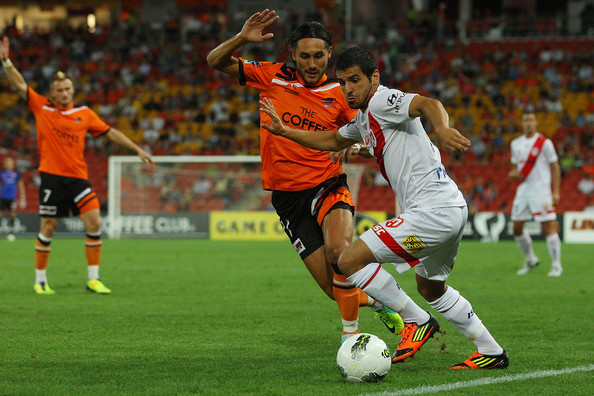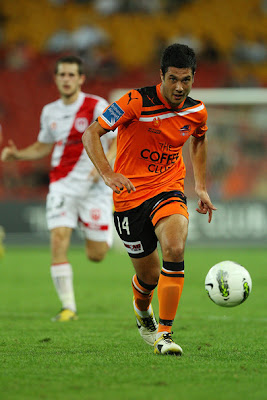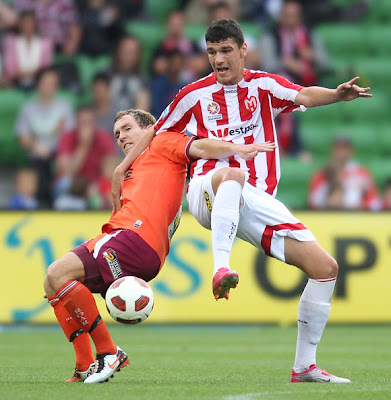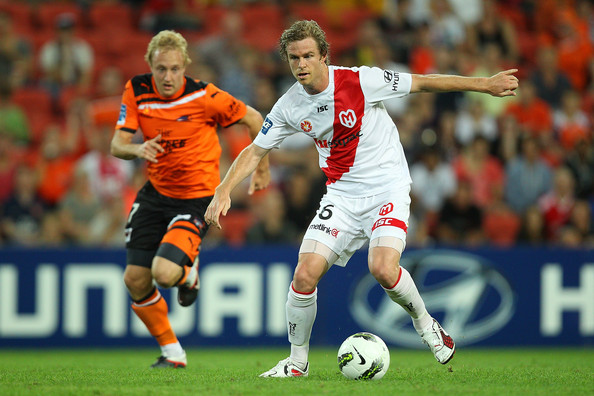Our first Pass and Move article is this brilliant tactical analysis of the Roar v Heart clash
I've often heard that first impressions count. Hopefully this makes for a good one. For those of you yet to stumble upon it, Pass and Move is a football blog dedicated to tactical analysis of the A-League and the Socceroos. Here is the latest match analysis of the Round 10 match between Brisbane Roar and Melbourne Heart. Thanks to Kevin and Katie for their support in joining FourFourTwo.
A clash of the titans. The two most innovative sides in the A-League era, Brisbane Roar and Melbourne Heart, fought for supremacy at Suncorp Stadium; if not quite a title deciding event, it will certainly be looked back upon with far greater reverence as a turning point in the evolution and growing sophistication of Australian football. The reigning champions Brisbane, reeling from the unexpected end of their record-setting 36-games unbeaten streak, were keen to demonstrate they are more than just a Thomas-Broich-and-Friends ensemble. Heart on the other hand, have been one of the most tactically fascinating teams in the the A-League. This was their chance to lay down a marker to the other clubs in the league, that they have finally realised their potential.
Brisbane's System:
Postecoglou was still without German maestro Thomas Broich and Brazilian forward Henrique. He deployed Brisbane in their customary 4-1-2-3 shape. Theoklitos was custodian, Jurman and Smith were paired in central defence, with Stefanutto and Franjic advanced at left and right fullback. Paartalu was the holder in midfield, with Murdocca and Nichols advanced. Berisha led the line, Issey was inverted on the right, with young winger Fitzgerald making his league debut.
Heart's System:
Van't Schip deployed Heart in an identical line-up to the one that saw off Wellington one-nil last weekend, probably the only time he has named an unchanged team this season. Bolton was between the sticks, Madaschi and Hamill were paired in central defence, with Behich and Marrone advanced at left and right fullback. Germano, Thompson and Fred were deployed in an archetypal destroyer/passer/creator midfield trio. Youthful target-man Babalj led the line, Duagandzic was narrow at right wing, with Worm wide on the left.
The Spare Man:
The concept of retaining a spare man in the defence was the determining factor for both side's formations. Brisbane, as we have seen previously, have the ability to organically switch between a three and four man defence; Paartalu, in the 'Busquets/modern centre half role' drops deep in between Smith and Jurman, becoming a third centre back, while Franjic and Stefanutto advance into midfield, becoming wingbacks, creating a 3-4-3. Van't Schip on the other hand, has recently used an Ajax inspired 3-3-1-3 with wingbacks against Adelaide, and a 3-4-3 diamond against Central Coast, to great effect.
But a three man defence is really only effective against a strike partnership; two centre backs man-mark, with the third as a sweeper. Against a lone striker, or a forward trio including two wingers, problems arise; either the two wingbacks get dragged back by the opposition wingers, leaving two centre backs redundant and a shortfall in midfield, or the two wide centre backs get dragged to the flanks by the opposition wingers, leaving enormous gaps in the defence that can be attacked by opposition runners.
With both van't Schip and Postecoglou never having deviated from a forward trio of a striker and two wide players, they were always going to opt for a conventional four-man backline, to retain a spare man and avoid becoming undermanned in defence.
Press:
Brisbane and Heart are the best pressing sides in the competition. Sydney were very effective at the high press last week, but their, in effect, man-marking scheme was a concession of inferiority; an admission that it was more important for them to stop Brisbane playing than it was to attack themselves.
In this match, both the home team and the visitors varied their use of the press, from a half press, standing relatively off and harrying once the ball possessor had crossed the centre circle, to a high press, preventing the centre backs from playing out from the back. This lent the match a predictable and natural rhythm. One side would assume control of possession, circulating and probing from flank to flank looking for the killer pass or cross, while the other would press within their defensive shape, trying to turn over the ball. When the ball was turned over, the roles were reversed.
An interesting feature of this match was how the midfields closed each other down. The two trios were reasonably fluid, with the caveat that Germano and Paartalu both sat deep compared to their two midfield colleagues, trying to stay goal side of the opposition's most advanced midfield player. The consequence of this was that the second most advanced player for both Brisbane and Heart received the most time on the ball. So for example, if Paartalu closed down Fred, and with Nichols trying to get past Germano, Murdocca received a decent amount of time on the ball. And vice versa, so that if Germano closed down Nichols, with Fred being marked by Paartalu, Thompson was gifted time on the ball.
Folding defences:
Both Heart and Brisbane were exceptionally defensively disciplined. Very often forward players doing defensive work is regarded as a bonus, but the reality is, in modern elite football, every player on the pitch has defensive and offensive responsibilities. When Brisbane were attacking, and with their fullbacks high up the pitch, Worm and Dugandzic would fold back into deep areas, operating almost as auxiliary fullbacks. The same can be said of Issey and Fitzgerald, retreating into deep areas to check the advances of Behich and Marrone.
One wing clipped, the other soars:
Another similarity was how both sides treated their wide men. Generally speaking the inverted right wingers Dugandzic and Issey looked to come inside and link with the striker while the left wingers Worm and Fitzgerald looked to stretch the play. Brisbane's wide players occasionally switched flanks, while Heart's wingers remained in place.
Striking differences:
So we've seen how similar both Heart and Brisbane are when it comes to their playing styles. Both favour high tempo pressing, compact midfields coupled with a possession oriented approach, attacking fullbacks and 'inverted' wingers or narrow forwards attacking from the flanks. What proved the difference, in this match and overall?
Despite losing against Heart, Postecoglou wasn't particularly out-thought in a tactical sense. It's a more a case of him being 'strategically outmanoeuvred'. As noted previously, Heart are really the only club in the the league that operate with a genuine squad rotation system. Assembling a true squad means having access first, to depth, and second, and perhaps more crucially, variation. Brisbane and Central Coast Mariners, for all their depth, don't have access to the tactical variety that van't Schip has carefully cultivated.
Take the central striker role as an example. Postecoglou only has two realistic options to field as the No 9, Besart Berisha and Kofi Danning, and even then, Danning has always been deployed as a right winger. They have more or less identical qualities as players, and can be described as pacey finishers.
Conversely, van't Schip can opt between pacey finisher Maycon, a creative deep-lying forward who can operate as a False Nine in Alex Terra, and an imposing target man with impressive hold-up play in the young Eli Babalj. And it was Babalj who made the difference in this game, winning the corner and creating space for the first goal and finishing the second.
We've seen in recent weeks, that Brisbane have struggled to penetrate defences who sit deep. They were held to a draw by Victory, despite their opponents being two men down, and by Wellington, who produced a disciplined defensive performance. The reason sitting deep is so effective against Brisbane is two fold; it minimises space between the lines of midfield and defence, denying Brisbane space to create passing angles in midfield, and it also restricts space behind the defence, denying Berisha or Danning the opportunity to unleash their fearsome acceleration, latching onto through balls. It also decreases the margin of error for the man playing the through pass; when the opposition backline sits deep, there is a greater chance that through balls will simply run to the opposition keeper.
So what is the merit in Heart's variation? Simply put, van't Schip holds an answer to all the possible questions. If Heart need a quick striker to get behind an opponent's high line, van't Schip can deploy Maycon. If Heart need a False Nine to bolster the midfield and unlock a massed defence, van't Schip can turn to Alex Terra. And if Heart need a physical/aerial option, to dissuade a defence sitting deep, van't Schip can field Babalj.
Against Brisbane, van't Schip opted for a combination of speed and strength. As noted previously, Babalj's role as a striker is very different to the domain of a traditional target man. Instead of primarily meeting crosses and occupying/pushing back the centre backs, Babalj's role revolves around hold-up play, in a manner reminiscent of Emile Heskey's role for England or perhaps even Dimitar Berbatov for Manchester United. In effect, he operates as an advanced fulcrum; Worm, Fred and Dugandzic were able to use Babalj to retain possession under pressure in advanced areas, secure in the knowledge that after they had made runs into space, Babalj would be be able to return possession.
Essentially, Heart were able to vary their strategy from direct play, exploiting Babalj's physical qualities, to a more patient and possession oriented approach, utilising the passing abilities of Thompson and Fred and then the sheer pace of Worm and Dugandzic on the flanks.
Brisbane on the other hand, were not able to do so. They were only dangerous when Heart's backline pushed up during the high press. When Heart reverted to a half press, with the defence standing off, they lacked the necessary penetration to pierce their defensive shape, and an aerial option to dissuade them from sitting deep.
Heart's Goals:
The first two goals were a perfect illustration of the physicality Babalj provides to the Red and Whites silky midfield play.
Germano 10' - A direct ball out of defence eventually reaches Babalj, via Fred. He looks to square the ball across the six-yard box but the ball is put out for a corner by Smith. Dugandzic delivers. Babalj stands between the width of the penalty spot and the far post. He makes a decoy run to the near post; as he does so, the man on the near post sidles closer, the man next to Theoklitos steps forward, and the man on the far post darts behind Theoklitos to harass Babalj. With this simple run, Babalj has sucked in three Brisbane defenders and left the far post completely vacant. Germano takes advantage, ghosts past Franjic and is given a free header. Babalj created the corner, and then the space for Germano's shot. In the aftermath, Slater lamented Brisbane not having a man on the far post; Brisbane actually did, its just that Babalj dragged him away.
Babalj 26' - This was a well worked goal, after a period of concerted pressure. The nearest stoppage in play was a Heart throw-in at 25:27, on the far touchline. Babalj's goal was registered at 26:35. In that minute or so of play, Heart completed approximately 24 passes. Though they conceded possession four times within that period, they regained it immediately, with Brisbane not able to register a single completed pass of their own, testament to the ferocity of Heart's press.
Germano played a 1-2 with Worm, who drew in three defenders and slipped a through ball behind the high Brisbane defence. At this point it was 3v3. Germano measured an inch-perfect cross which evaded Theoklitos, Smith and Jurman and reached Dugandzic on the right flank, who cut it back for Babalj to finish assuredly.
Substitutions:
On 64', Postecoglou made two aggressive substitutions in an effort to get back into the contest. He exchanged Issey, who had produced an inconsistent performance, for lucky left winger Rocky Viconte, and central midfielder Murdocca for speedy attacker Kofi Danning. Brisbane shifted to an all-out attacking 4-2-4, with Paartalu and Nichols in midfield, and a forward line of Visconte, Berisha, Fitzgerald and Danning.
This was a clever move by Postecoglou. Heart had started to play more conservatively, trying to kill the game by keeping possession. Changing to a direct style jarred the Heart defence, and they found themselves overwhelmed by sheer numbers.
On 77', Postecoglou reaped his reward with Nichols' goal.Theoklitos passed to Jurman, then to Fitzgerald, then to Danning on the edge of the area. This indicated Brisbane's speed of transition, from defence to attack within three passes. Danning managed to accelerate past leftback Behich, creating a yard of space for a low cross. This was parried by Bolton on the near post, though unfortunately for him, into the path of Nichols.
It should be said however that Heart were beginning to play rather naively. They resumed holding a high defensive line, which only benefited Danning and Berisha, and Bolton begun to punt goal kicks far up the pitch, instead of retaining control of possession. But without Babalj's aerial prowess, having been substituted off for Hoffman, these goal kicks became Brisbane's fastest route back to possession. The commentators highlighted the identical two goal deficit to Brisbane's famous Grand Final comeback last season, but in fact it was this inability/unwillingness of the visiting side to keep possession that was the most pertinent similarity. Just as Central Coast's carelessness in possession allowed the Oranje a route to the Championship, Heart's new found sloppiness nearly did the same, albeit for lesser stakes.
The Death Star plans are not in the main computer:
After going undefeated for a record 36 games, Brisbane have been held to two draws and experienced two defeats, at the hands of teams they would have expected to beat, and beat with panache.
In a word, Brisbane have lacked penetration. Their midfield and forward line has become too focused on retaining possession to the detriment of constructing attacks. A similar phenomenon has been experienced by Spain.
It should be noted that in this particular match, Roar were deprived of Thomas Broich and Henrique, two players who are equally capable of making their mark in one-on-one situations, to tip the balance.
With Berisha more easily restricted by deep defences, and unable to offer a physical option, how can Postecoglou solve this problem of a lack of penetration? There are two possible solutions.
The first is to recruit a target-man. Against defences that sit deep, Brisbane might do well to go for an aerial option. As noted previously, Spain, the international masters of possession football, are not above sticking a big man up-front and telling him to win balls in the air. In their recent match against Scotland, having failed to unlock a stubborn tartan defence, Del Bosque threw on Athletico Bilbao's imposing target man Fernando Llorente, and he eventually netted the winner, from a very un-Iberian cross. This option might seem a philosophical departure from Postecoglou's preferred style of football, but Heart have demonstrated how to incorporate physical qualities to facilitate possession football.
Another option to unlock massed defences would be introducing a False Nine. Physicality isn't the only method of achieving penetration (yes, yes, that's what she said). As Barcelona have demonstrated, technical quality is always the trump card, and fielding Broich or Henrique in that False Nine role could provide greater attacking flexibility and creativity from the central striker role. It would also provide the most natural and unobtrusive solution within the squad. For instance, if Berisha as striker and Broich/Henrique on the wings isn't working, instead of using up one of his substitutions, Postecoglou can simply switch Berisha to the wing, and Broich or Henrique to the False Nine role. Broich or Henrique could then dictate play, with Berisha using his pace to provide a goal-threat from wide in a manner similar to Mirko Vucinic for Roma when Francesco Totti was deployed as a False Nine for Roma.
It is very likely Postecoglou has considered this second option. There were tentative reports Broich was being utilised in this way in pre-season, and of course Broich was used as a False Nine for a ten minute period in their Round 1 Match against Central Coast, where he created Nichols' match winner. Is Postecoglou simply saving this tactic for a decisive moment later in the season? The first time Lionel Messi started a match in the False Nine role that has helped define his stellar talent, was during their 2008-9 Champions League final against Manchester United in Rome - his switching positions with Samuel Eto'o completely bamboozled the Red Devils defence.
Conclusion:
This was a match between two of the most innovative sides in the A-League era. Heart were able to triumph in this contest because they had access to tactical variation - they were able to alternate between retaining possession with the technical quality of Fred and Thompson and using the speed of Worm and Dugandzic, to a more direct style, exploiting the physical qualities of Babalj. Brisbane conversely were unable to, and Berisha was almost entirely restricted when Heart reverted to a half press, sitting deeper.
What is the significance of this result for the respective seasons of both clubs? As PM predicted previously, the Top 3 now reads Brisbane, Central Coast and Heart - deservedly so. It should be remembered Brisbane were deprived of two key performers and will undoubtedly mount a resurgence. Every campaign goes through peaks and troughs. Postecoglou should find a solution; if it is indeed going to be the False Nine, he already has the raw materials at his disposal - quick forwards in Danning and Berisha, creative deep-lying forwards in Broich and Henrique and a creative attacking midfielder comfortable in making runs from deep in Nichols.
Heart's victory is a testament to van't Schip's managerial acumen, and the way he has gone about assembling tactical variation in his squad (Babalj the target man, Terra the False Nine and Maycon the quick striker), within a stringent salary cap, has been nothing less than brilliant, and might just be a unique achievement in world football. After a shaky start that revealed questionable defensive frailties, Heart are finally beginning to mount a concerted title challenge.
Player Rankings (for novelty value):
Brisbane | Heart:
10) Issey | Hamill
9) Fitzgerald | Madaschi
8) Berisha | Marrone
7) Stefanutto | Behich
6) Smith | Thompson
5) Jurman | Worm
4) Franjic | Dugandzic
3) Murdocca | Fred
2) Nichols | Germano
1) Paartalu | Babalj
Related Articles
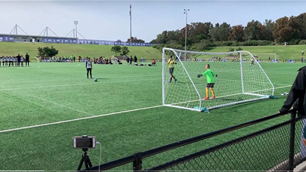
Fresh talent flock to ambitious A-League outfit's pro pathway

Why A-League 20/21 is crucial for Olyroos’ medal hopes



